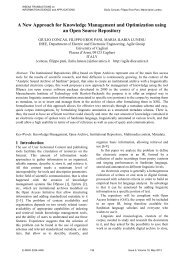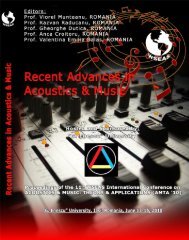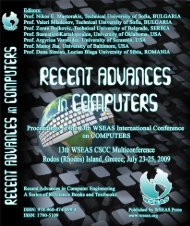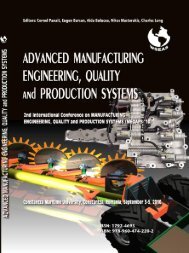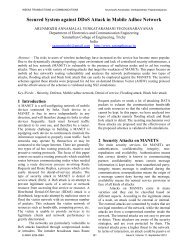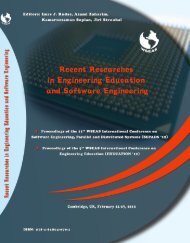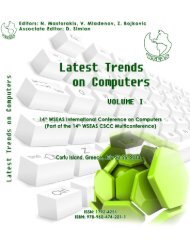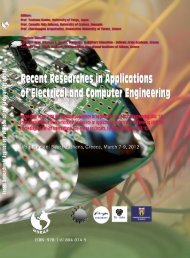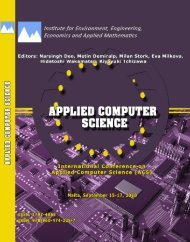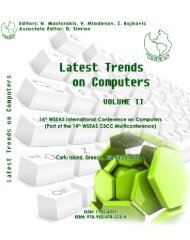(ECC '10) Universitatea Politehnica Bucharest, Romania ... - Wseas.us
(ECC '10) Universitatea Politehnica Bucharest, Romania ... - Wseas.us
(ECC '10) Universitatea Politehnica Bucharest, Romania ... - Wseas.us
- No tags were found...
Create successful ePaper yourself
Turn your PDF publications into a flip-book with our unique Google optimized e-Paper software.
EUROPEAN COMPUTING<br />
CONFERENCE<br />
Proceedings of the 4th EUROPEAN COMPUTING CONFERENCE<br />
(<strong>ECC</strong> <strong>'10</strong>)<br />
<strong>Universitatea</strong> <strong>Politehnica</strong><br />
<strong>Bucharest</strong>, <strong>Romania</strong>, April 20-22, 2010<br />
SPONSOR and ORGANIZER:<br />
Facultatea IMST, <strong>Universitatea</strong> <strong>Politehnica</strong>, <strong>Bucharest</strong>, <strong>Romania</strong><br />
Electrical and Computer Engineering Series<br />
A Series of Reference Books and Textbooks<br />
Published by WSEAS Press ISSN: 1790-5117<br />
www.wseas.org<br />
ISBN: 978-960-474-178-6
EUROPEAN COMPUTING<br />
CONFERENCE<br />
Proceedings of the 4th EUROPEAN COMPUTING CONFERENCE<br />
(<strong>ECC</strong> <strong>'10</strong>)<br />
<strong>Universitatea</strong> <strong>Politehnica</strong>, <strong>Bucharest</strong>, <strong>Romania</strong>, April 20-22, 2010<br />
SPONSOR and ORGANIZER:<br />
Facultatea IMST, <strong>Universitatea</strong> <strong>Politehnica</strong>, <strong>Bucharest</strong>, <strong>Romania</strong><br />
Electrical and Computer Engineering Series<br />
A Series of Reference Books and Textbooks<br />
Published by WSEAS Press<br />
www.wseas.org<br />
Copyright © 2010, by WSEAS Press<br />
All the copyright of the present book belongs to the World Scientific and Engineering Academy and<br />
Society Press. All rights reserved. No part of this publication may be reproduced, stored in a retrieval<br />
system, or transmitted in any form or by any means, electronic, mechanical, photocopying, recording, or<br />
otherwise, without the prior written permission of the Editor of World Scientific and Engineering Academy<br />
and Society Press.<br />
All papers of the present volume were peer reviewed by two independent reviewers. Acceptance was<br />
granted when both reviewers' recommendations were positive.<br />
See also: http://www.worldses.org/review/index.html<br />
ISSN: 1790-5117<br />
ISBN: 978-960-474-178-6<br />
World Scientific and Engineering Academy and Society
EUROPEAN COMPUTING<br />
CONFERENCE<br />
Proceedings of the 4th EUROPEAN COMPUTING CONFERENCE<br />
(<strong>ECC</strong> <strong>'10</strong>)<br />
<strong>Universitatea</strong> <strong>Politehnica</strong>, <strong>Bucharest</strong>, <strong>Romania</strong>, April 20-22, 2010<br />
SPONSOR and ORGANIZER:<br />
Facultatea IMST, <strong>Universitatea</strong> <strong>Politehnica</strong>, <strong>Bucharest</strong>, <strong>Romania</strong>
Editors:<br />
Prof. Mircea Grigoriu, University "<strong>Politehnica</strong>" of <strong>Bucharest</strong>, ROMANIA<br />
Prof. Valeri Mladenov, Technical University of Sofia, BULGARIA<br />
Prof. Cornelia Aida Bulucea, University of Craiova, ROMANIA<br />
Prof. Olga Martin, University "<strong>Politehnica</strong>" of <strong>Bucharest</strong>, ROMANIA<br />
Prof. Nikos Mastorakis, Technical University of Sofia, BULGARIA<br />
International Program Committee Members:<br />
John Tsitsiklis, USA<br />
Irwin W. Sandberg, USA<br />
Viola Vogel, SWITZERLAND<br />
Dimitris Bertsekas, USA<br />
Lena Valavani, USA<br />
Leonid G. Kazovsky, USA<br />
Leon O. Chua, USA<br />
Brian A. Barsky, USA<br />
K. R. Rao, USA<br />
Bimal K. Bose, USA<br />
Joseph Sifakis, FRANCE<br />
Paul E. Dimotakis, USA<br />
Sidney Burr<strong>us</strong>, USA<br />
Biswa Nath Datta, USA<br />
George Giannakis, USA<br />
Nikolaos Bourbakis, USA<br />
Yorgo Istefanopulos, TURKEY<br />
George E Andrews, USA<br />
Stuart S. Antman, USA<br />
Soren H. Morup, DENMARK<br />
Robert A. Kosinski, POLAND<br />
Ivan L'Heureux, CANADA<br />
Alexander G. Ramm, USA<br />
Steven Collicott, USA<br />
Wilfried B. Kraetzig, GERMANY<br />
Panos Pardalos, USA<br />
Ronald Yager, USA<br />
Stamatios Kartalopoulos, USA<br />
Kleanthis Psarris, USA<br />
Borje Forssell, NORWAY<br />
Metin Demiralp, TURKEY<br />
Constantin Udriste, ROMANIA<br />
Amauri Caballero, USA<br />
Geir Oien, NORWAY<br />
George Vachtsevanos, USA<br />
Spyros Tragoudas, USA<br />
Olga Martin, ROMANIA<br />
Demetrios Kazakos, USA<br />
Gamal Elnagar, USA<br />
Periklis Papadopoulos, USA<br />
Mircea Grigoriu, ROMANIA<br />
Elena Cristina Ragazzi-Rada, ITALY<br />
Catalin Amza, ROMANIA<br />
Constantin Radu, ROMANIA<br />
Constantin Mari<strong>us</strong> Popescu, ROMANIA<br />
Ion Cleju, ROMANIA<br />
Emil Sofron, ROMANIA
Preface<br />
This year the 4th EUROPEAN COMPUTING CONFERENCE (<strong>ECC</strong> <strong>'10</strong>) was held at<br />
<strong>Universitatea</strong> <strong>Politehnica</strong>, <strong>Bucharest</strong>, <strong>Romania</strong>, April 20-22, 2010. The conference remains<br />
faithful to its original idea of providing a platform to disc<strong>us</strong>s software engineering, hardware<br />
engineering, artificial intelligence, cryptology, computer vision, remote sensing, robotics, fuzzy<br />
logic, graph theory, supercomputing, computers in education etc. with participants from all over<br />
the world, both from academia and from ind<strong>us</strong>try.<br />
Its success is reflected in the papers received, with participants coming from several countries,<br />
allowing a real multinational multicultural exchange of experiences and ideas.<br />
The accepted papers of this conference are published in this Book that will be indexed by ISI.<br />
Please, check it: www.worldses.org/indexes as well as in the CD-ROM Proceedings. They will<br />
be also available in the E-Library of the WSEAS. The best papers will be also promoted in many<br />
Journals for further evaluation.<br />
A Conference such as this can only succeed as a team effort, so the Editors want to thank the<br />
International Scientific Committee and the Reviewers for their excellent work in reviewing the<br />
papers as well as their invaluable input and advice.<br />
The Editors
Proceedings of the 4th EUROPEAN COMPUTING CONFERENCE<br />
Table of Contents<br />
Plenary Lecture 1: Computer-Aided Process Planning and Scheduling Software for Make-to-<br />
Order Manufacturing of Machined Parts<br />
Madalin Catana<br />
13<br />
Plenary Lecture 2: Statecharts Disentangled 14<br />
Albert Hoogewijs<br />
Plenary Lecture 3: AI Tools for Speech Analysis 15<br />
Horia-Nicolai Teodorescu<br />
Absence of Eigenvalues for Integro-Differential Operators 17<br />
Mari<strong>us</strong>-Marinel Stanescu, Dumitru Bolcu, Sabin Rizescu, Paul Rinderu<br />
CELICA: A Multi-Agent Communication System for Electronic Commerce 23<br />
Cristea Boboila, Nicolae Constantinescu<br />
Using Smart Cards and X.509 Digital Certificates for a Student Management Information<br />
System at the University of Prishtina<br />
Blerim Rexha, Haxhi Lajqi, Myzafere Limani<br />
29<br />
On an Optimal Parametric Iteration Method for Thin Film Flow 34<br />
Vasile Marinca, Nicolae Herisanu, Dumitru Bala<br />
Statecharts Disentangled 39<br />
Benjamin De Leeuw, Albert Hoogewijs<br />
Stochastic Timed Automata Simulator 52<br />
Vaclav Kaczmarczyk, Michal Sir, Zdenek Bradac<br />
Prediction Error Feedback for Time Series Prediction: A Way to Improve the Accuracy of<br />
Predictions<br />
Ryad Zemouri, Paul Ciprian Patic<br />
58<br />
Modelling the Transport Phenomenon Involved in the F<strong>us</strong>ion-Welded 63<br />
Ioan Sorin Leoveanu, Daniel Ta<strong>us</strong><br />
Blind Equalization based on Information Theoretic Learning for Impulsive Noise<br />
Environments<br />
Namyong Kim, Hyung-Gi Byun<br />
69<br />
Symbolic Equation <strong>us</strong>ing Modified Nodal Analysis for Linear Electrical Circuit <strong>us</strong>ing Matlab 73<br />
Zoltan Erdei, Luiza Alexandra Dicso, Liviu Neamt, Oliver Chiver<br />
Competency-based E-assessment in Project Management and Firm Performance: A Case<br />
Study<br />
Constanta Nicoleta Bodea, Maria Dascalu<br />
76<br />
ISSN: 1790-5117 9 ISBN: 978-960-474-178-6
Proceedings of the 4th EUROPEAN COMPUTING CONFERENCE<br />
J<strong>us</strong>t-In-Time Planning and Scheduling of Machining Operations on Parts: An Ill<strong>us</strong>trative Case<br />
Study<br />
Madalin Catana<br />
82<br />
A Model of Product Personality 88<br />
Andrei Dumitrescu<br />
Current Trends in Product Development 94<br />
Mihaela Lupeanu, Corneliu Neagu, Alina Neacsu<br />
Centralized Control System for Entry into Buildings 100<br />
Mari<strong>us</strong>-Constantin Popescu, Mircea Grigoriu<br />
Pressure Adj<strong>us</strong>ting Algorithm Command for a Chamber 106<br />
Mari<strong>us</strong>-Constantin Popescu, Mircea Grigoriu<br />
Text Analytics as a Form of Knowledge Mining 112<br />
Zeljko Panian<br />
Modelling of Water Turbulent Flow in a Elipsocyclonic Nozzle 118<br />
Mircea Grigoriu, Lucian Burlacu, Dan Victor Cavaropol<br />
Numerical Simulation of Pollutants Dispersion in Storage Lakes 122<br />
Mircea Grigoriu, Liviu–valentin Balanescu, Dan Victor Cavaropol, Mari<strong>us</strong> Constantin Popescu<br />
Evaluation of Form Deviations <strong>us</strong>ing Genetic Algorithms: Circularity Problem 126<br />
Daniel-Silviu Manolache<br />
Using Program Specific Search Operators in Test Data Generation 132<br />
Mohammad Alshraideh<br />
The Accessibility of Information in Computer Assisted Learning Process for Persons with<br />
Disabilities<br />
Narcisa Isaila, Ion Smeureanu<br />
139<br />
XML Authoring Tool 143<br />
Mihai Teohari, Copcea Larisa<br />
Hybrid Expert System Shell 148<br />
Petr Polach, Jan Valenta, Vaclav Jirsik<br />
Contribution to the Implementation of the e-Infrastructure Concept at the National Level 154<br />
Gabriel Neagu, Alexandru Stanciu<br />
Comparative Study on Applicability of Two Novel Effort Estimation Models in Web Projects 160<br />
Ljubomir Lazic, Nikos E. Mastorakis<br />
Nonholonomic Geometry of Economic Systems 170<br />
Constantin Udriste, Massimiliano Ferrara, Dorel Zugravescu, Florin Munteanu<br />
The Usage of a Software to Process the SF-36 Data 178<br />
Ion Moleavin, Cristina-Elena Dobrescu<br />
Wavelet-Based Signal Analysis of a Vehicle Crash Test With a Fixed Safety Barrier 183<br />
Hamid Reza Karimi, Kjell G. Robbersmyr<br />
ISSN: 1790-5117 10 ISBN: 978-960-474-178-6
Proceedings of the 4th EUROPEAN COMPUTING CONFERENCE<br />
Fully Automated and Hidden System for Wiping Sensitive Data 189<br />
George Pecherle, Cornelia Gyorodi, Robert Gyorodi, Bogdan Andronic<br />
Mathematical Modeling and Analysis of a Vehicle Crash 194<br />
Witold Pawl<strong>us</strong>, Jan Eivind Nielsen, Hamid Reza Karimi, Kjell G. Robbersmyr<br />
Formal Verification of Secure Ad Hoc Routing Protocols <strong>us</strong>ing AVISPA: ARAN Case Study 200<br />
Mihai-Lica Pura, Victor-Valeriu Patriciu, Ion Bica<br />
GHSOM-Based Web Service Discovery 207<br />
Florie Ismaili, Bogdan Shishedjiev, Xhemal Zenuni, Bujar Raufi<br />
Web Page Analysis Based on HTML DOM and Its Usage for Forum Statistics and Alerts 212<br />
Robert Gyorodi, Cornelia Gyorodi, George Pecherle, George Mihai Cornea<br />
Using Java in B<strong>us</strong>iness Applications 218<br />
Danut-Octavian Simion<br />
A Solution for Secure SIP Conferencing over IMS and SAE 224<br />
Cristina-Elena Vintila<br />
Solutions for Traffic Lights Intersections Control 230<br />
Mari<strong>us</strong> Constantin Popescu, Constantin Ranea, Mircea Grigoriu, Mari<strong>us</strong>-Constantin Popescu,<br />
Constantin Ranea<br />
Natural Language Processing for Rapid Information 237<br />
Maria Moise, Ciprian Gheorghe, Marilena Zingale<br />
Nonlinear Command Simulation for Pump Functioning Powered by Electrical Drives 243<br />
Mari<strong>us</strong>-Constantin Popescu, Mircea Grigoriu<br />
A Multi - Agent Based Architecture to Qualitative Temporal Constraint Reasoning 249<br />
Tahar Guerram, Ramdane Maamri, Zaidi Sahnoun<br />
Geographical Information System Module for Deriving the Flash Flood Hydrograph in<br />
Mountaino<strong>us</strong> Areas<br />
Matei Domnita, Aug<strong>us</strong>tin Ionut Craciun, Ionel Haidu, Saska-Zsolt Magyari<br />
260<br />
Thermo Process Monitoring Bars Medium Voltage under Short-Circuit Regim 266<br />
Cristinel Popescu, Mari<strong>us</strong>-Constantin Popescu, Constantin Ranea<br />
AI Tools for Speech Analysis Applied to the <strong>Romania</strong>n Language 272<br />
Horia-Nicolai Teodorescu<br />
Rate Control and Mode decision Jointly Optimization in H.264AVC 280<br />
Siavash Eshaghi, Hassan Farsi<br />
A New Parallel Sorting on Diamond Architecture 284<br />
Masumeh Damrudi, Kamal Jadidy Aval<br />
Authors Index 288<br />
ISSN: 1790-5117 11 ISBN: 978-960-474-178-6
Proceedings of the 4th EUROPEAN COMPUTING CONFERENCE<br />
ISSN: 1790-5117 12 ISBN: 978-960-474-178-6
Proceedings of the 4th EUROPEAN COMPUTING CONFERENCE<br />
Plenary Lecture 1<br />
Computer-Aided Process Planning and Scheduling Software for Make-to-Order<br />
Manufacturing of Machined Parts<br />
Dr. Madalin Catana<br />
Department of Machine Manufacturing Technology<br />
Faculty of Engineering and Management of Technological Systems<br />
University POLITEHNICA of <strong>Bucharest</strong><br />
ROMANIA<br />
E-mail: mg_catana@yahoo.com<br />
Abstract: Process planning is a key function of manufacturing companies that is responsible for the determination of<br />
methods by which a product is to be manufactured economically and competitively. To efficiently perform this<br />
function, computer-aided process planning (CAPP) systems are widely <strong>us</strong>ed. On the other hand, scheduling is<br />
another important function of manufacturing companies that gives the time each manufacturing operation should start<br />
and finish on assigned machine for the due dates of manufactured products to be efficiently met. Many computeraided<br />
scheduling (CAS) systems are being <strong>us</strong>ed for the optimization of scheduling function. Unfortunately, beca<strong>us</strong>e a<br />
poor collaboration or integration of CAPP and CAS systems, scheduling problems may occur in overloaded shops or<br />
high production costs may be obtained even for optimized process plans. The CAPP-CAS software that will be<br />
disc<strong>us</strong>sed during the lecture is a solution to overcome process planning and scheduling collaboration problems at<br />
make-to-order manufacturing of machined parts. There will be described the working sessions with the software, in<br />
terms of inputted data and outputted results. Some concluding remarks will be made on the quality of planning and<br />
scheduling solutions delivered by the software and on its future development.<br />
Brief Biography of the Speaker:<br />
Madalin Catana graduated in 1991 the Faculty of Machine Manufacturing Technology from Polytechnic Institute of<br />
<strong>Bucharest</strong>, <strong>Romania</strong>. He received his Ph.D. degree in Ind<strong>us</strong>trial Engineering from University POLITEHNICA of<br />
<strong>Bucharest</strong>, <strong>Romania</strong>, in 2002, with a thesis on computer-aided process structure planning and scheduling of<br />
machining and assembly processes in machine manufacturing ind<strong>us</strong>try. Since 1998 he is a lecturer in the department<br />
of Machine Manufacturing Technology, Faculty of Engineering and Management of Technological Systems,<br />
University POLITEHNICA of <strong>Bucharest</strong>.<br />
His current research interests include manufacturing technologies, production management, modeling and simulation<br />
of manufacturing processes and systems, and CAD/CAPP/CAM technologies. He has co-authored more than 40<br />
papers published in <strong>Romania</strong>n technical journals and proceedings of national and international conferences, and 10<br />
academic books and laboratory guides on production engineering and management, assembly and machining<br />
technologies, and computer numerical control programming. He performed researches within 6 national research<br />
projects.<br />
At present, he is a member of Academic Association of Manufacturing Engineering, <strong>Romania</strong>, and of <strong>Romania</strong>n<br />
Association for Economic Engineering.<br />
ISSN: 1790-5117 13 ISBN: 978-960-474-178-6
Proceedings of the 4th EUROPEAN COMPUTING CONFERENCE<br />
Plenary Lecture 2<br />
Statecharts Disentangled<br />
Professor Albert Hoogewijs<br />
Co-Author: Benjamin De Leeuw<br />
Ghent University<br />
Department of Pure Mathematics and Computer Algebra<br />
Krijgslaan 281, S22<br />
B-9000 GHENT<br />
BELGIUM<br />
E-mail: albert.hoogewijs@ugent.be<br />
Abstract: We present the main results of the research obtained by Benjamin De Leeuw in his PhD thesis: Statechart<br />
DNA: Formal and Psychological Investigation into a Machine Theory. We derive the simplified statechart (language)<br />
by excluding all redundant constructs of the UML (Unified Modeling Language) metamodel on statecharts. Simplified<br />
state machines and their memory model are the central abstraction <strong>us</strong>ed throughout this work. Any UML state<br />
machine or procedural program transforms to exactly one simplified state machine. We derive the language grammar<br />
for simplified state machines by composing a scripting language that further abstracts any <strong>us</strong>eful state machine. Each<br />
grammar rule gets a visual counterpart within the state machine diagram and we show how all <strong>us</strong>eful state machines<br />
can be grown from these scripts. The parse tree of this grammar can be normalized such that any state machine has<br />
exactly one script, called statechart dna.<br />
The first practical application is the generation of state machine test cases for tools having them as their domain of<br />
discourse. The second application of the theory is model checking state machine behavior without assuming<br />
interleaved action execution. We show how the less strenuo<strong>us</strong> location consistency ordering, can be <strong>us</strong>ed to<br />
calculate more realistic views on memory state values. We introduce a weighted and recursively calculated numerical<br />
value to each grammar rule application and from it derive a <strong>us</strong>eful and measurable state machine complexity metric.<br />
Another important application is the detection of changes in state machine specifications. Text versioning systems<br />
<strong>us</strong>e the ability to reconstruct any previo<strong>us</strong>ly checked-in version from keeping track of so-called delta sets or change<br />
sets. In case of structured text like procedural program code it is even possible to automatically merge these text<br />
documents. Within the above theoretical framework we derive a technique to calculate delta sets on state machines<br />
and on how to handle merges consistently.<br />
Brief Biography of the Speaker:<br />
Albert Hoogewijs obtained his PhD in mathematics from the University of Ghent in 1974. He studied logic at the<br />
University of Utrecht with Dirk van Dalen. He worked on three-valued logic for software specification, and was visiting<br />
professor at several European Universities, in the context of the Galois Network, an Erasm<strong>us</strong> project in mathematics<br />
and computer science. He is full professor at the Department of Pure Mathematics and Computer Algebra of the<br />
University of Ghent. He supervised several PhD theses and wrote a lot of articles in the area of automated theorem<br />
proving and software specification.<br />
ISSN: 1790-5117 14 ISBN: 978-960-474-178-6
Proceedings of the 4th EUROPEAN COMPUTING CONFERENCE<br />
Plenary Lecture 3<br />
AI Tools for Speech Analysis<br />
Professor Horia-Nicolai Teodorescu<br />
Co-Authors: Laura Pistol, Monica Feraru, Mari<strong>us</strong> Zbancioc, Ioan Pavaloi<br />
Gheorghe Asachi Technical University of Iasi<br />
and<br />
Institute for Computer Science, <strong>Romania</strong>n Academy<br />
ROMANIA<br />
E-mail: hteodor@etc.tuiasi.ro<br />
Abstract: Speech involves huge amounts of information that only recently and still partly can be analyzed with a level<br />
of sophistication comparable to the human brain. For most languages, few progresses have been done in their<br />
detailed analysis <strong>us</strong>ing automatic means and many linguists and phoneticians still rely on their hearing in speech<br />
evaluation. An interdisciplinary group from four institutions in Iasi, <strong>Romania</strong>, has united their efforts during more than<br />
a decade for the advancement of tools for the understanding of spoken language processes like prosody, emotional<br />
speech and personal characteristics of the voice. A consistent repository for the <strong>Romania</strong>n language, with a vast<br />
section on emotional speech was created and is available on the web. Problems overviewed in this plenary talk are<br />
the analysis and description and recognition of emotions in voice, the comparison of emotional speech characteristics<br />
in different European languages, interaction of grammar and speech in specific grammatical constructions, spoken<br />
language statistics of the <strong>Romania</strong>n language, and pathologies’ effects on speech. We overview the principles of the<br />
computational tools developed and the results of speech analysis, with an emphasis on spoken language statistics<br />
and emotional analysis and recognition in speech. The tools presented include GRID applications for statistical<br />
analysis of voice, serial programs for automatic speech pattern identification with biometric and data mining<br />
applications, programs for precise determination of the prosodic traits like voice pitch, and programs for statistical<br />
characterization of emotional speech.<br />
Brief Biography of the Speaker:<br />
Prof. dr.dr.h.c. Horia-Nicolai L. TEODORESCU is a correspondent member of the <strong>Romania</strong>n Academy (since 1994)<br />
in the Science and Information Technology Section and IEEE Senior member. He is a professor at the Faculty of<br />
Electronics, Telecommunications and Information Technology, Dept. Applied Electronics and Intelligent Systems, The<br />
“Gheorghe Asachi” Technical University of Iasi. He is a Vice-Rector for International Relations and Academic Image.<br />
Also, he is the Director of the Institute of Computer Science, <strong>Romania</strong>n Academy.<br />
He authored, co-authored, or co-edited more than 25 books and about 300 papers and holds 24 national and<br />
international patents (numero<strong>us</strong> gold, silver and bronze medals at invention fairs in Br<strong>us</strong>sels, Geneva, Tunis etc.)<br />
He acts as Vice-president of the Commission for the Informatisation of the <strong>Romania</strong>n Language, Chairman of the<br />
Commission for Fuzzy Systems and IA -<strong>Romania</strong>n Academy, Iasi Branch (since 2004), is a member of the Panel<br />
Information Technology, SPS-NATO (2008-2011). Prof. Teodorescu is Founding editor for many scientific reviews,<br />
member or former member of editorial committees for numero<strong>us</strong> journals from <strong>Romania</strong> or from abroad (former<br />
Associate Editor, IEEE Trans. Men, Systems, Cybernetics C; Fuzzy Sets and Systems; J. General Systems). He was<br />
the initiator and a promoter for many national and international scientific societies (SIGEF, AEDEM, the <strong>Romania</strong>n<br />
Society for Fuzzy Systems and the Balkan Union for Fuzzy Systems and Artificial Intelligence – BUFSA).<br />
ISSN: 1790-5117 15 ISBN: 978-960-474-178-6
Proceedings of the 4th EUROPEAN COMPUTING CONFERENCE<br />
Authors Index<br />
Alshraideh, M. 132 Gyorodi, R. 189, 212 Patriciu, V.-V. 200<br />
Andronic, B. 189 Haidu, I. 260 Pawl<strong>us</strong>, W. 194<br />
Aval, K. J. 284 Herisanu, N. 34 Pecherle, G. 189, 212<br />
Bala, D. 34 Hoogewijs, A. 39 Polach, P. 148<br />
Balanescu, L.-V. 122 Ionut Craciun, A. I. 260 Popescu, C. 266<br />
Bica, I. 200 Isaila, N. 139 Popescu, M.-C. 100, 106, 122<br />
Boboila, C. 23 Ismaili, F. 207 Popescu, M.-C. 230, 243, 266<br />
Bodea, C. N. 76 Jirsik, V. 148 Pura, M.-L. 200<br />
Bolcu, D. 17 Kaczmarczyk, V. 52 Ranea, C. 230, 266<br />
Bradac, Z. 52 Karimi, H. R. 183, 194 Raufi, B. 207<br />
Burlacu, L. 118 Kim, N. 69 Rexha, B. 29<br />
Byun, H.-G. 69 Lajqi, H. 29 Rinderu, P. 17<br />
Catana, M. 82 Lazic, L. 160 Rizescu, S. 17<br />
Cavaropol, D. V. 118, 122 Leoveanu, I. S. 63 Robbersmyr, K. G. 183, 194<br />
Chiver, O. 73 Limani, M. 29 Sahnoun, Z. 249<br />
Constantinescu, N. 23 Lupeanu, M. 94 Shishedjiev, B. 207<br />
Copcea, L. 143 Maamri, R. 249 Simion, D.-O. 218<br />
Cornea, G. M. 212 Magyari, S.-Z. 260 Sir, M. 52<br />
Damrudi, M. 284 Manolache, D.-S. 126 Smeureanu, I. 139<br />
Dascalu, M. 76 Marinca, V. 34 Stanciu, A. 154<br />
De Leeuw, B. 39 Mastorakis, N. E. 160 Stanescu, M.-M. 17<br />
Dicso, L. A. 73 Matei, D. 260 Ta<strong>us</strong>, D. 63<br />
Dobrescu, C.-E. 178 Moise, M. 237 Teodorescu, H.-N. 272<br />
Dumitrescu, A. 88 Moleavin, I. 178 Teohari, M. 143<br />
Eshaghi, S. 280 Munteanu, F. 170 Udriste, C. 170<br />
Farsi, H. 280 Neacsu, A. 94 Valenta, J. 148<br />
Ferrara, M. 170 Neagu, C. 94 Vintila, C.-E. 224<br />
Gheorghe, C. 237 Neagu, G. 154 Zemouri, R. 58<br />
Grigoriu, M. 100, 106, 118 Neamt, L. 73 Zenuni, X. 207<br />
Grigoriu, M. 122, 230, 243 Nielsen, J. E. 194 Zingale, M. 237<br />
Guerram, T. 249 Panian, Z. 112 Zoltan Erdei, Z. 73<br />
Gyorodi, C. 189, 212 Patic, P. C. 58 Zugravescu, D. 170<br />
ISSN: 1790-5117 288 ISBN: 978-960-474-178-6




